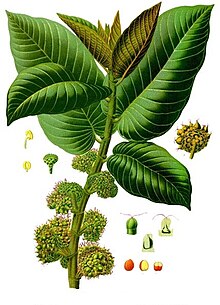
Back Moraceae Afrikaans توتية Arabic توتيه ARZ Moraceae AST Tutkimilər Azerbaijani توت کیمیلر AZB Moraceae BCL Тутавыя Byelorussian Черничеви Bulgarian মোরাসি Bengali/Bangla
| Moraceae Temporal range: Cretaceous – Recent
| |
|---|---|

| |
| Panama rubber tree (Castilla elastica) | |
| Scientific classification | |
| Kingdom: | Plantae |
| Clade: | Tracheophytes |
| Clade: | Angiosperms |
| Clade: | Eudicots |
| Clade: | Rosids |
| Order: | Rosales |
| Family: | Moraceae Gaudich. (1835) nom. cons.[1][2] |
| Genera[2] | |
|
48; see text | |
The Moraceae—often called the mulberry family or fig family—are a family of flowering plants comprising about 38 genera and over 1100 species.[3] Most are widespread in tropical and subtropical regions, less so in temperate climates; however, their distribution is cosmopolitan overall. The only synapomorphy within the Moraceae is presence of laticifers and milky sap in all parenchymatous tissues, but generally useful field characters include two carpels sometimes with one reduced, compound inconspicuous flowers, and compound fruits.[4] The family includes well-known plants such as the fig, banyan, breadfruit, jackfruit, mulberry, and Osage orange. The 'flowers' of Moraceae are often pseudanthia (reduced inflorescences).

- ^ Angiosperm Phylogeny Group (2009). "An update of the Angiosperm Phylogeny Group classification for the orders and families of flowering plants: APG III" (PDF). Botanical Journal of the Linnean Society. 161 (2): 105–121. doi:10.1111/j.1095-8339.2009.00996.x. hdl:10654/18083. Retrieved 2013-07-06.
- ^ a b Moraceae Gaudich. Plants of the World Online. Retrieved 22 April 2024.
- ^ Christenhusz, M. J. M.; Byng, J. W. (2016). "The number of known plants species in the world and its annual increase". Phytotaxa. 261 (3): 201–217. doi:10.11646/phytotaxa.261.3.1.
- ^ Judd WS, Campbell CS, Kellogg EA, Stevens PF, Donoghue MJ (2008). Plant Systematics: A Phylogenetic Approach. Sunderland, MA: Sinauer Associates, Inc. pp. 1–620. ISBN 978-0-878-93407-2.